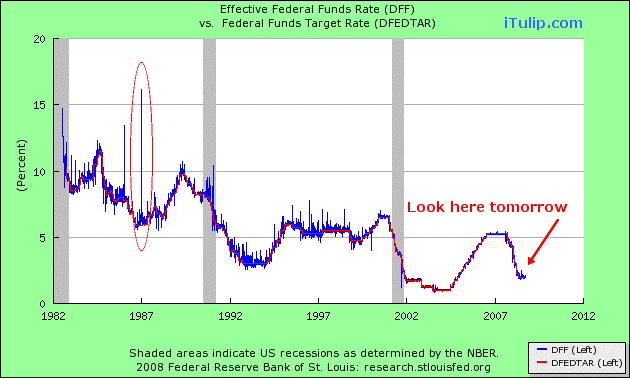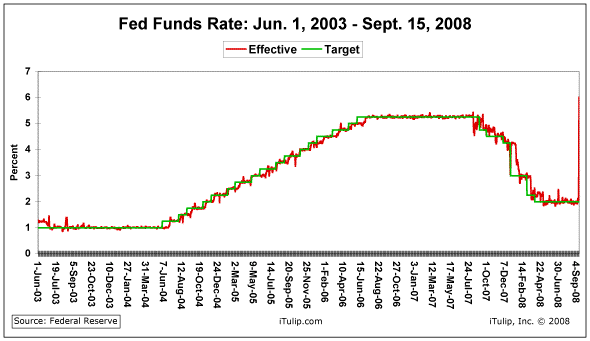 |
The last time the Fed Funds target rate got this out of line with the effective rate was in 1987, and from a base of over 6% not 2%. On a percentage basis, at three times the target rate the spread is unprecedented. It happened today.
Fed funds jump to 6 pct in mkt, tripling Fed's target
NEW YORK NEW YORK, Sept 15 (Reuters) - Federal funds traded in the U.S. interbank lending market were indicated to have jumped to 6 percent on Monday, tripling the target rate of 2 percent which the Federal Reserve sets.
The move happened even after the Federal Reserve earlier added $20 billion of temporary reserves to the banking system via overnight repurchase agreements.
Early Monday, at around 7:10 a.m. EDT in New York, federal funds had traded at 2.0625 percent. When market inter-bank lending rates shoot up, that often reflects distrust among financial institutions of lending to some other counterparties. Global market participants' risk aversion has surged on Monday as the U.S. banking crisis has escalated, analysts say.
AntiSpin: The Fed tries to manage the economy and inflation by influencing short term interest rates. It does that by buying and selling government bonds in the bond market in what are called "open market operations." They set a target rate, such as 2%, then buy or sell bonds as needed until the effective rate in the bond market matches the target rate objective. Problem is, this process does not always work in times of crisis because the bond markets themselves may be dis-functional, as is the case today. NEW YORK NEW YORK, Sept 15 (Reuters) - Federal funds traded in the U.S. interbank lending market were indicated to have jumped to 6 percent on Monday, tripling the target rate of 2 percent which the Federal Reserve sets.
The move happened even after the Federal Reserve earlier added $20 billion of temporary reserves to the banking system via overnight repurchase agreements.
Early Monday, at around 7:10 a.m. EDT in New York, federal funds had traded at 2.0625 percent. When market inter-bank lending rates shoot up, that often reflects distrust among financial institutions of lending to some other counterparties. Global market participants' risk aversion has surged on Monday as the U.S. banking crisis has escalated, analysts say.
Really, really dis-functional.
In 1987 during the crash the Fed Funds target rate was 6% but the effective rate jumped more than two times to 16% as banks lost confidence in lending to each other. Today that spread looks benign.
On Friday Sept. 12, the effective funds rate was 2.1 percent, only 10 basis points over the target rate. Now the effective rate is three times the target rate. What it means is that the banks are so distrustful of each other's credit that they do not want to lend to each other. Who can blame them? Lehman Bros. went out of business today leaving its creditors holding the bag to the tune of $630 billion in defaulted debt.
``If the fed funds rate closes high today, I would be really worried as it would mean that there really is no money out there to be lent,'' said Stan Jonas, who trades interest- rate derivatives at Axiom Management Partners LLC in New York.
- Bloomberg
These episodes usually don't last long. It will be interesting to see what happens next. - Bloomberg
Today's mega spread between the Fed target and effective rate has not shown up in the Fed's graph yet today. Look for it tonight or tomorrow.

Addendum: Sept. 16, 2008
Appears that the Fed doesn't want to show the data on its web site so we've charted the data ourselves.

iTulip Select: The Investment Thesis for the Next Cycle™
__________________________________________________
To receive the iTulip Newsletter or iTulip Alerts, Join our FREE Email Mailing List
Copyright © iTulip, Inc. 1998 - 2007 All Rights Reserved
All information provided "as is" for informational purposes only, not intended for trading purposes or advice. Nothing appearing on this website should be considered a recommendation to buy or to sell any security or related financial instrument. iTulip, Inc. is not liable for any informational errors, incompleteness, or delays, or for any actions taken in reliance on information contained herein. Full Disclaimer
Appears that the Fed doesn't want to show the data on its web site so we've charted the data ourselves.

iTulip Select: The Investment Thesis for the Next Cycle™
__________________________________________________
To receive the iTulip Newsletter or iTulip Alerts, Join our FREE Email Mailing List
Copyright © iTulip, Inc. 1998 - 2007 All Rights Reserved
All information provided "as is" for informational purposes only, not intended for trading purposes or advice. Nothing appearing on this website should be considered a recommendation to buy or to sell any security or related financial instrument. iTulip, Inc. is not liable for any informational errors, incompleteness, or delays, or for any actions taken in reliance on information contained herein. Full Disclaimer




Comment